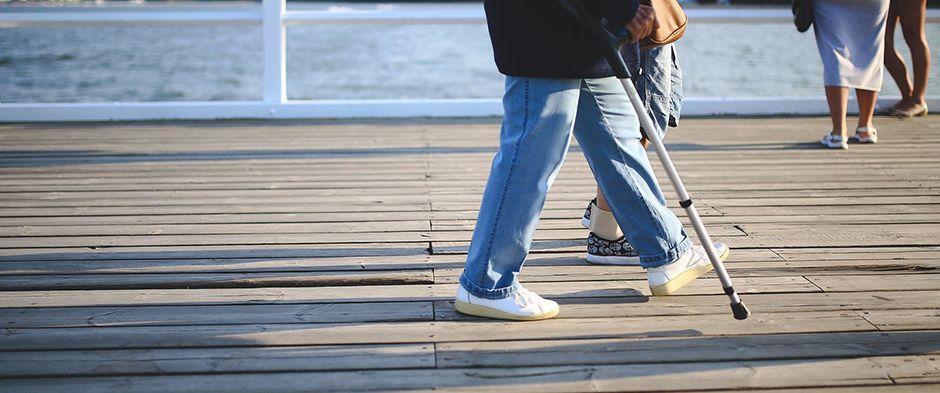
6 Tips for the Correct Use of Forearm Crutches
Sally Madeley-Carr, OT07 Feb 2020
Using crutches in the correct manner is important. Whether you are recovering from an operation or injury, or you need them for a chronic condition, it's vital that you both size them correctly and deploy the right technique when using them as a walking aid.
Crutches require a degree of balance and upper body strength. If you have an injured leg, they transfer weight through your good leg and the upper body. This reduces stress on injured area, assisting recovery.
If you have injuries to both of your legs, in the vast majority of cases, crutches will not be suitable. It is strongly recommended that you seek the advice of a medical professional with first-hand knowledge of your condition before using them.
There are many kinds of walking aid available and it may be that another type - like a walking frame or rollator walker - might be more suitable for your specific needs.
The most common design found in the UK are 'forearm' models. These have the familiar horizontal handle, offset upper shaft and 'cuff' which fits around the forearm towards the elbow. This channels weight through the hands, arms and upper body, reducing stress on an injured leg or foot. Usually made from aluminium, they are lightweight and easy to manoeuvre.
Here we'll run-through some of the things to think about when using this type of crutches.
1. Size
You can adjust the overall length of forearm crutches using the pin-clip mechanism on the lower shaft. To size correctly, the height of the horizontal handle should be level with your wrists as your arms hang naturally by your side.
If you have double-adjustable crutches, you can also set the length of the offset upper shaft. This is done via a second pin-clip mechanism.
Ideally, there should be a gap of about three finger widths between your elbow and the top of the forearm cuff. This should result in a roughly 20-30 degree bend in your elbow when holding the handle.
2. Walking technique
These walking aids are suitable for partial weight-bearing, non-weight-bearing and full weight-bearing situations. If you are able to put some weight on your injured leg, you can move the crutches forward together before taking a step forward, first with your bad leg to join them, then with your good leg on its own.
If you're unable to put any weight through your bad leg, you can use the crutches to take your entire body-weight. Move the crutches forward first and then step with your good leg to catch up with them, keeping your bad one off the ground.
When you first start using crutches, it's a good idea to use very short steps. As your injury improves or you feel more confident, you can increase the length of your steps.
You will find that your technique and balance improves with practice.
3. Using the stairs
With the right technique, forearm crutches are suitable to safely negotiate steps and staircases. This gives them a significant advantage over wheeled mobility aids like a rollator walker.
When descending, with your weight on your good leg, place the feet of both crutches and your bad foot on the lower step. You will need to slightly bend your good leg and keep our back as vertical as possible in order to do this. Then transfer your weight forward so that your good foot joins your bad one and the crutches on the lower step.
This process ensures your injured leg is never exposed to uncontrolled weight.
When ascending, reverse the process. Here, step up first with your good leg alone, then join it both with your bad leg and both crutches at the same time. On this basis, the crutches always stay in line with the bad foot.
4. Hand grips
Forearm crutches transfer weight not only through the arms but also the hands. Most standard issue models have fairly narrow plastic handles. If used a lot, this can cause pain for some people.
To combat this, some models are available with wider grips, spreading weight over a greater area and improving comfort. Other crutches have 'ergonomic' handles, which are wide and contoured to match the shape of the palm. People using crutches for sustained periods tend to find this type of handle beneficial.
You can also buy extra hand pads which fit over the existing handles. They are foam filled so provide a later of padding to ease and pressure on the hands.
5. Closed cuff or open cuff
The 'cuff' is the moulded plastic section which fits around the forearm about 2-3 inches below the elbow.
Open cuff versions are also known as 'Euro' or 'European' crutches. Here, the cuff does not encircle the arm to any great degree. Instead it splays wide and may have a flatter area where the forearm connects.
Because they don't grip the forearm, they do not impede the arms if the user loses balance.
This moulded plastic is sometimes available in different colours, making this type of crutch popular if you want something more appealing in appearance than the standard-issue grey. Open cuffs are also less likely to catch on the arms of clothing.
This design is typically lightweight, less bulky and generally pleasing to the eye.
An obvious drawback of open cuff crutches is that they are more prone to falling to the floor. Closed cuffs encircle or partially encircle the forearm, so if you do lose grip with your hand, they usually stay put.
Bending down can be a significant problem for many people with injuries or chronic conditions, so this detail may be significant.
Closed cuff models are the ones typically supplied by the NHS and are the most common style found in the UK.
As mentioned, their 'cuff' section is moulded plastic and goes around the forearm a few inches from the elbow. Many have hinges where the cuff meets the upper shaft. This creates a pivot, improving the sense of freedom of movement, especially when the user is stationary.
The design allows someone to use their hands for other things while the crutch hangs via the cuff from their arm.
Essentialaids.com supplies a high quality range of open cuff and closed cuff crutches. As described above, most models come with pin-clips which allow adjustment to fit the frame of the user.
There are others though, which don't adjust in this way but have other benefits which often make them the choice of people who need crutches on a permanent basis.
6. Consider permanent use crutches
A drawback of adjustment pin-clips is they tend to cause a certain degree of flexibility in the shafts. Added to this, you may find they are fairly noisy when in use, with the metal squeaking and rattling because of the adjustment mechanism.
For these reasons, those with chronic conditions necessitating the use of crutches, often choose 'permanent user' models. Rather than pin-clips, these need cutting to size using a hacksaw. This is a straightforward process as the aluminium shafts are easy to saw through.
It is important to fit the rubber or plastic foot at the bottom of each crutch, known as a 'ferrule', before use. These are similar to the feet found on shower stools or anything with metal legs that contacts hard surfaces. They provide the valuable function of providing grip on the ground and reduce the chance of slipping.
Good quality ferrules have an internal metal 'washer'. This prevents the aluminium tubing of the crutch gradually cutting through at the base.
The more 'solid' shaft of the non-adjustable crutches gives them a different feeling - more rigid and certainly much quieter when in use.
Most of these models are fitted with the wider, ergonomically shaped handles mentioned earlier. Over time, these are easier on the hands.
Choosing forearm or underarm crutches
Underarm, sometimes called axillary or 'axilla' crutches, have a different design to forearm models. These have a single shaft at the bottom, which then splits into two for the upper section. A horizontal pad fits under the arm, with another for the hands at about hip level. This style has more in common with the very old fashioned 'pirate' crutches.
As with forearm models, underarms can usually be adjusted for overall length and for the height of the hand grips. Made from aluminium, most people find them more difficulty to manoeuvre than the alternative.
They are certainly bulkier and heavier objects, which in itself is a drawback for many people. Remember that you need to have space to store, stand them up or lay them down when you are not actually using them to walk around.
Using axilla crutches incorrectly also runs the risk of pressure under the armpits causing damage. To use them safely, there should be a gap of two or three inches under the armpit and above the top support pad, when you are stationary.
This ensures weight does not channel through this area of the body and is instead focused on the hands, arms and shoulders. Unfortunately, in practice this guidance is easily ignored and weight placed on the armpit can cause nerve damage and second injury. As forearm crutches do not carry this danger, it might be considered another advantage of their use.
Crutches over wheeled walkers?
While often used in recovery from injury, crutches can also be useful for people with long-term mobility issues. They are an excellent alternative to mobility aids with wheels like a rollator walker. One of the main advantages is that they more easily negotiate steps and small threshold obstacles, common in many homes and gardens.
Nevertheless, it's important to remember that crutches are rarely recommended if you have issues or injury to both legs. For those situations, other types of walking aids are usually more suitable.

Sally Madeley-Carr, OT
Sally qualified as an Occupational Therapist in 1996 and is a well-respected professional in the field of rehabilitation equipment and living aids. She has worked in private practice and within the NHS, developing a broad experience with adults and children. Click here for Sally's registration with the Health and Care Professions Council. The HCPC regulates health, psychological and social work professionals in the UK.